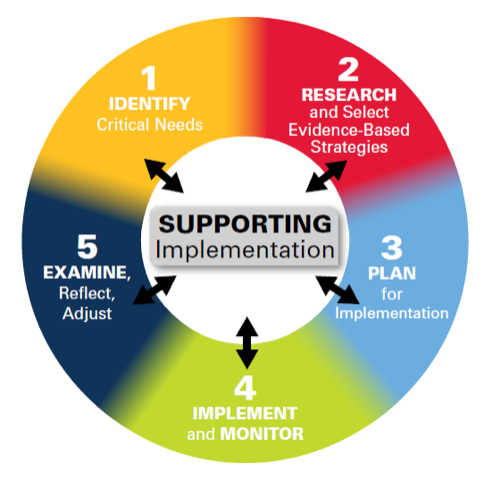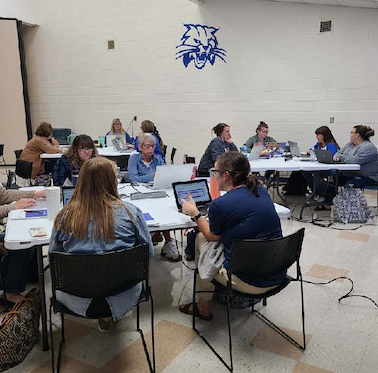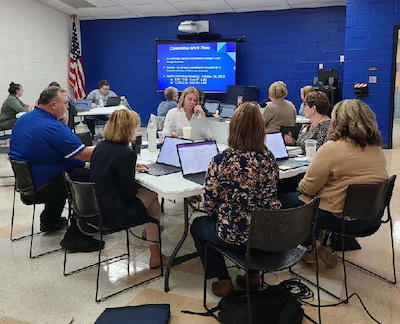District Development of ‘One Plan’ Focuses Work on What Matters Most: Addressing Whole Child Needs for Improved Outcomes

Ohio’s ED STEPS (Education Department’s System of Tiered E-Plans and Supports) is, according to, theOhio Department of Education, a “process for improving the way the Department coordinates, collaborates, and communicates to support districts and schools in addressing their needs” (See https://education.ohio.gov/Topics/Federal-Programs/EDSTEPS/ED-STEPS-FAQs#FAQ3744 for more information).
Composed of the One Needs Assessment (ONA), “One Plan,” and Funding Application (the CCIP), ED STEPS replaced older web-based tools (e.g., the Decision Framework) supporting the Ohio Improvement Process (OIP).

Even though the tools are different, their intent remains the same – to support districts and schools in improving opportunities and outcomes for each child through the use of the five-step plan-do-study-act (PDSA) process:
- District leadership teams (DLTs), building leadership teams (BLTs), and teacher-based teams (TBTs) review data and identify critical needs and root causes (ONA);
- Teams analyze critical needs and root causes to prioritize areas of focus and develop a limited number of focused (SMART) goals and research evidence-based strategies (ONA and One Plan);
- Teams remove barriers, identify resources, and consider ways to document and share adult and student measures for implementation and monitoring (One Plan);
- Teams implement One Plan strategies and actions steps. Adult and student data are collected via evidence gathering and progress monitoring; and
- Teams examine, reflect, and adjust support structures, as well as adult and student measures.

Reaffirming Needs
The process of developing the Cambridge City Schools One Plan began two years ago with completion of the ONA. “It was an eye opener for our entire district,” said Rose Marie Daymut, the district’s Director of Federal Programs and 6-12 Curriculum. “As crazy as it may sound, getting to do the One Needs Assessment started the whole process of looking at our problem areas and everything we needed to do,” she added.
Located in southeast Guernsey County in the foothills of the Appalachian Mountains, Cambridge City Schools serves more than 1,800 students in four buildings: a primary (grades K-2), intermediate (grades 3-5), middle (grades 6-8), and high school (grades 9-12). Three out of every four Cambridge students meet the state’s definition of economically disadvantaged; about 21% of the district’s students are identified as students with a disability, exceeding the state average of about 15%.
“This area experienced a loss of industry and the effects of the opioid crisis and we’re at a different status economically. We have a lot of children that have been affected by this and a large homeless and unaccompanaied youth population. We have to take care of them, make sure they feel they’re in a safe place, and help them focus on learning,” explained Daymut. “We provide wrap-around services and are truly are working to develop and take care of the whole child.” The Ohio Department of Education (ODE) defines a whole child approach as broadening “district and school focus beyond academics to include meeting students' socialemotional, physical and safety needs.” (see ODE’s Whole Child Framework for more information).
Ohio’s most recent state report card, released on September 14, 2023, uses a new star rating system that rates districts and schools on five key components: achievement, progress, gap closing, early literacy, and graduation (see ODE’s Guide to the 2023 Ohio School Report Cards for more information). Cambridge City Schools met state standards in early (K-3) literacy and in closing educational gaps. According to the report card, the district needs support in meeting achievement, progress, and graduation targets.
“We looked to the OIP to support the kind of improvements we needed to make and continue making,” said Daymut. Ohio’s improvement framework – the Ohio Improvement Process – combines two key components, both supported by evidence: (1) use of a PDSA cycle and (2) use of data teams. Data teams in Ohio’s model are aligned and connected across the district (DLT), school (BLT), and classroom (TBT) levels, creating an ongoing culture of inquiry increasing coherence in focus and implementation, and supporting continuous systemwide improvement.
OIP Resources
The Ohio Improvement Process (OIP), used by the majority of local education agencies in Ohio, relies on (1) the the use of a cycle of inquiry commonly known as a PDSA cycle (i.e., the Ohio 5-step process) in combination with (2) the use of aligned data teams at each level – in Ohio, known as district leadership teams (DLTs), building leadership teams (BLTs), and teacher-based teams (TBTs). Strong evidence exists to support both components. For more information, see Ohio’s Leadership Development Framework (BASA, 2022) and the following online modules from the Ohio Leadership Advisory Council and short videos describing the process.
OLAC online OIP Modules
- TBTs: Bottom-Up and Top-Down (September 2022) at https://ohioleadership.org/m/264
Howley and Howley (2023, p. 1-2), in a review of the literature on the key features of Ohio’s model (data teams and PDSA cycles), concluded that:
By contrast to both traditional fragmented improvement efforts and the missteps of policy-level reform, the OIP positions educational improvement as a systemic problem with particular attention to the local level, with the improvement of teaching—as well as learning—at the center of concern. The OIP reflects an understanding of the complexity of local school systems: (a) the many parts influence each other, (b) coordination and communication are challenging, and (c) the system is cultural and dynamic rather than technical and linear (see, e.g., Alsbury et al., 2018; Fullan, 2001, 2020; Organisation for Economic Cooperation and Development, 2016).2 The OIP’s aligned, nested, and collaborative leadership teams—at teacher, school, and district levels—and its five-step process combine in local districts to address systemic challenges by introducing systemic routines of collaboration, communication, and inquiry (Buckeye Association of School Administrators, 2022).

District-wide Focus, Shared Leadership Are Key
“Anything we needed to do, we needed to build at the district level first,” explained Daymut. “We were able to include every part of our district, classified and unclassified staff, and even the kitchen staff, bus drivers, and custodians in conducting our ONA. We wanted different outlooks and perspectives in responding to the ONA questions. It was a lot of work, but the conversation, the collaboration, and just the feeling of being a part of something made it worthwhile,” added Daymut.
Engaged All in Identifying Critical Needs.
As staff from across the district worked to identify the most pressing needs, three areas emerged as priorities: literacy, mathematics, and culture and climate (including attending to the mental health of students). “Using root cause analysis, we found that what we really needed to look at, of course, was literacy,” said Daymut. According to Daymut, many Cambridge children enter kindergarten with very limited vocabulary. “The vocabulary that our children enter school with is a lot lower than the national average so they’re almost coming in as English language learners. Definitely, literacy is always one of our biggest concerns,” said Daymut.

In the area of mathematics, Daymut said that the district had not had a new curriculum in 20 years. “Teachers were using Teachers Pay Teachers in the absence of district-provided resources and there was no vertical alignment,” added Daymut.
A third area of priority involved attending to the social-emotional needs and well-being of students, including addressing mental health needs. “We have a lot of children who are in homeless situations or are second generation, and lot of families that are doubled up, living together, due to minimal finances,” said Daymut.
“When we talk about the need to address mental health concerns, that need is not only for our students and what they’re going through, but also, second hand, for what our teachers are going through in trying to meet student needs and teach them at the same time,” she added.
A fourth goal area – safe and healthy schools – incorporates the use of positive behavioral interventions and supports (PBIS). Additionally working with families and the community, and finding ways to deliver relevant and useful professional learning on a district-wide basis, are district priorities. One example of the community ‘stepping up’ is allowing children and youth, including unaccompanied youth, to have clean clothes. “We purchased bags for dirty clothes and fill them up, and then an area laundromat picks them up and washes, folds, and returns the clothes. This is amazing and a huge thing!” exclaimed Daymut.
Altering Team Structures & Processes to Increase Focus and Coherence.
“I wanted to look first at our DLT. It’s leading the district,” said Daymut in recalling the development and implementation of evidencebased strategies to address identified needs. “It was the right time for us to look at our DLT and build a different structure,” she said.

Daymut described the longstanding structure of the DLT as having no purpose other than to check a box and say ‘yes, we do this.’ “We were doing the same things over and over and nothing was happening. Our DLT meetings were down to every other month or about four times a year. Daymut has served on the DLT for about 15 years, the last six of which as the central office administrator responsible for facilitating the meetings. “I sat there and I thought, well, you know what, if we continue doing things the way we're doing them, we're gonna get the same results,” said Daymut.
Under Daymut’s leadership, the DLT membership, structure, process, and schedule were altered to ensure wider engagement of all district and school personnel. School principals are focused on improving outcomes for children and youth in their schools as well as working to improve the capacity of the district to improve teaching and learning district-wide. “Everybody was involved. It's not just me and it's really not just the people sitting in that meeting,” said Daymut.
“We looked at our One Plan and our four goal areas – literacy, math, culture and climate, and PBIS – and then along with that One Plan, the fact that each building has a priority goal.” DLT membership was reestablished to include the principal of each of the four school buildings in the district, plus three additional people from each of the four schools. “I told the principals, ‘I want you to pick three people in your building to serve; someone who will show good leadership and be able to take information back and get it implemented in your buildings.’ These individuals – the three from each building – are members of their school’s BLT,” said Daymut.
“Our principals are good at working as a team. They want to help with the improvement of our district.”
-Rose Marie Daymut, Director of Federal Programs and 6-12 Curriculum, Cambridge City Schools
The district’s business manager, treasurer, and Education Management Information System (EMIS) coordinator, and nurse; representatives from bus transportation and kitchen service; and parents are all part of the DLT. Members choose which of the four DLT committees (one for each goal area) they wish to join, and each committee has representation from all buildings in the district.
“Principals step out of their administrative role. They are at the same level as everybody else. I want everyone on the team to talk and, if they wish, to select a leader to facilitate the meeting. That person does not have to be an administrator. I want shared leadership. And that part has been wonderful because to be honest with you, sometimes our principals do want to just step down and participate and not have to be the leader,” Daymut explained.
“In the past, everyone was responsible for everything and nothing got done. Now, each committee is responsible for activities related to only one goal,” Daymut added.

Fullan and Kirtman (2019, p. 36) encourage district and school leaders to focus direction, cultivate collaborative cultures, deepen learning, and secure accountability as four components for increasing coherence in systemwide improvement efforts. Cambridge’s restructuring of the DLT and the interaction across team structures (from DLT to BLT to TBT and from TBT to BLT to DLT) served to remove conflicting priorities, reduce isolated practice, and increase focus and coherence in order to make and sustain meaningful improvement across the district.
At the school level, “four people representing each of those goals sit down with the rest of their BLT team. And they talk about each goal individually. And that's how they learn about it. They take each one of those goals from that BLT to their TBT meetings because our BLT consists of all the department heads from each one of our curriculum areas. Documentation is completed for every step in the process and open for all to see in a shared document. The information flow is constant – the data they’re using, what their next steps are, their action steps. It’s all transparent,” said Daymut.

At any point in the process, BLT and TBT members can request assistance or ask a question through the shared application and get answers quickly. “If a BLT member has a question that needs to come to me about funding or a question that goes to the superintendent or to our data specialists, I can respond immediately. I’ve gotten questions from TBTs like ‘Rose, can you look into PD on this to help fill the gap,’ I have that information in an instant and can respond,” explained Daymut. “In the past, nobody ever knew what the DLT did. Now everybody's involved because they're getting the information so really it's no longer from top down; it’s top down and bottom up,” she added.
Cambridge’s DLT meets as a full team every other month. On alternate months, the committees meet to work on their assigned goal areas. “They have that extra month. They come back and they have what they need; they work out their next steps,” said Daymut. “We have more vertical alignment in English Language Arts and math. Teams are actually talking about instructional strategies and considering different data, including progress monitoring data from our MTSS process, to drive our instruction,” Daymut explained.

“Anything related to MTSS goes to our TBTs. We would not be able to see the same gains and improvement through MTSS without OIP team structures. You need everybody to be involved,” said Daymut. BLTs meet monthly and TBTs meet every other week. Consultants from State Support Team region 12 support the DLT, and the educational service center (ESC) support the work and sits in on meetings at all levels.
Cambridge has extended learning through the addition of after school programs funded by 21st Century Community Learning Center (CCLC) grants that provide academic support for children from less advantaged backgrounds. The district also sponsored a summer program that served over 450 children during the full months of June and July 2023. “We had 60 to 70 employees – teachers, cooks, bus drivers – that worked all summer and were excited to come back for the opening of the new school year. We had a summer program like no other!,” said Daymut.
Improving Outcomes through Shared Leadership.
Daymut describes the change to move from insular work to effective functioning as a unit. “The changes we’ve made in using OIP have allowed educators to learn from each other and be collectively more able to meet student needs. We've opened the lines of communication for one thing and they feel heard, whereas before, if it was, if they were on their own island. We're building more trust and changing the culture in our district through the transparency of all of the information. Everybody understands what we’re doing and why we’re doing it.”
Daymut credits the progress the district has made to the strength of each individual team member and to the collective strength of the team in guiding continuous improvement efforts. “It’s been the best thing we’ve ever done!”
References
Alsbury, T. L., Blanchard, M. R., Gutierrez, K. S., Allred, C. M., & Tolin, A. D. (2018). District strategic teaming: Leadership for systemic and sustainable reform. Research in Educational Administration & Leadership, 3(2), 139–177.
Buckeye Association of School Administrators (BASA). (2022). Ohio's leadership development framework (3rd ed.). https://ohioleadership.org/storage/ocali-ims-sites/ocali-ims- olac/documents/13073-OLAC-Book-2021-WEB.pdf
Fullan, M. (2020). The nature of leadership is changing. European Journal of Education, 55(2), 139–142. https://doi.org/10.1111/ejed.12388
Fullan, M., & Kirtman, L. (2019). Coherent school leadership: Forging clarity from complexity. ASCD.
Fullan, M. (2001). The new meaning of educational change. Teachers College Press.
Howley, C. B., & Howley, A. (2023). The evidence basis for primary features of the Ohio Improvement Process (OIP): Data-driven decision making within leadership teams. WordFarmers Associates.
Organisation for Economic Cooperation and Development. (2016). School leadership for learning: Insights from TALIS 2013. OECD.
For More Information
For more information about how OIP is being used by Cambridge City Schools, contact:
- Rose Marie Daymut, Director of Federal Programs and 6-12 Curriculum, Cambridge City Schools, at rose.daymut@cambridgecityschools.org.
For more information about resources to support districts, contact:
- OLAC Director Mike Trego at trego@basa-ohio.org, or
- OLAC Consultants Jim Gay, PhD at jimgay@basa-ohio.org or Karel Oxley at Oxley@basa-ohio.org.